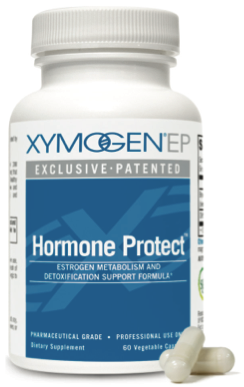
DIM (diindolylmethane) DIM is an advanced metabolite of indole-3-carbinol (I3C), the indole found in cruciferous vegetables. Supplementation with DIM is preferred over I3C due to I3C’s undesirable breakdown products, including the dioxin-like molecule indolo[3,2-b] carbazole (ICZ). It has been established that DIM supplementation increases 2-hydroxylation of estrogen. This science has been validated in animal and human studies wherein supplementation with DIM was shown to increase the ratio of the protective, “good” 2-hydroxyestrone (2-OH) to 16alpha hydroxyestrone (16alpha-OH). In a study of postmenopausal women, DIM-treated subjects, relative to placebo, showed an increase of 47% in 2-OH/16alpha-OH. Studies further reveal that DIM may play a critical role in supporting normal cellular proliferation in estrogen-sensitive tissues.*
Sulforaphane Glucosinolate (SGS) Sulforaphane is the aglycone breakdown product of glucoraphanin, a glucosinolate also known as SGS. The SGS broccoli seed extract used in Hormone Protect is a super vegetable that delivers extended antioxidant support and boasts a very high level of glucoraphanin (13%). Research suggests that when SGS is broken down to sulforaphane (its active form), it safely and effectively upregulates the Nrf2 system, activates the antioxidant response element (ARE), enhances the production of important antioxidants, and activates vital phase II detoxification enzymes. These mechanisms provide protection from toxins, xenobiotics (e.g., xenoestrogens), and reactive intermediates formed after phase I detoxification.*
Neutralizing Reactive Estrogen Quinones with SGS According to Bolton et al, the oxidation of catechol estrogens (2-OH and 4-OH) via cytochrome P450 enzymes generates reactive electrophilic estrogen quinones and reactive oxygen species (ROS) through redox cycling. Formation of quinones is largely minimized via phase II methylation, which produces methoxyestrogens. However, if methylation is suboptimal, estrogen quinones, which can cause DNA damage in estrogen-sensitive tissues, must be neutralized via other phase II enzymes such as quinone reductase. According to researchers, estrogen quinones are now recognized as a significant mechanism of estrogen-mediated cell damage. A promising strategy to address their deleterious effects involves the use of agents to favorably shift the balance between phase I and phase II enzymes. In fact, phase II enzymes such as quinone reductase, heme oxygenase-1 (HO-1), and glutathione S-transferase (GST) have been suggested as targets for reducing these highly reactive estrogen quinones.*
Sulforaphane has been identified as an agent that possesses the ability to potently induce phase II detoxification enzymes—including quinone reductase, HO-1, GST, and glutathione reductase—as well as to inhibit phase I enzymes involved in activation. In the case of estrogen quinones, quinone reductase protects cells from oxidative damage by two-electron reduction, thus suppressing oxidative cycling and reactive oxygen species generation. Sulforaphane consumption is associated with supporting cell-line health in humans, and animal research shows that sulforaphane metabolites can be found in target tissues, along with significant induction of quinone reductase and HO-1. This research has exciting implications for supporting the health of tissues as it relates to reactive estrogen quinones formed after phase I activation of catechol estrogens (2-OH, 4-OH).*
Directions:
Take one to two capsules daily, or as directed by your healthcare practitioner.
References:
1. Herrmann S, Seidelin M, Bisgaard HC, et al. Indolo[3,2-b]carbazole inhibits gap junctional intercellular communication in rat primary hepatocytes and acts as a potential tumor promoter. Carcinogenesis. 2002 Nov;23(11):1861-68. [PMID: 12419834]
2. Rajoria S, Suriano R, Parmar PS, et al. 3,3’-diindolylmethane modulates estrogen metabolism in patients with thyroid proliferative disease: a pilot study. Thyroid. 2011 Mar;21(3):299-304. [PMID: 21254914]
3. Sepkovic DW, Stein J, Carlisle AD, et al. Diindolylmethane inhibits cervical dysplasia, alters estrogen metabolism, and enhances immune response in the K14-HPV16 transgenic mouse model. Cancer Epidemiol Biomarkers Prev. 2009 Nov;18(11):2957-64. [PMID: 19861518]
4. Dalessandri KM, Firestone GL, Fitch MD, et al. Pilot study: effect of 3,3’-diindolylmethane supplements on urinary hormone metabolites in postmenopausal women with a history of early-stage breast cancer. Nutr Cancer. 2004;50(2):161-67. [PMID: 15623462]
5. Del Priore G, Gudipudi DK, Montemarano N, et al. Oral diindolylmethane (DIM): pilot evaluation of a nonsurgical treatment for cervical dysplasia. Gynecol Oncol. 2010 Mar;116(3):464-67. [PMID: 19939441]
6. Fares F, Azzam N, Appel B, et al. The potential efficacy of 3,3’-diindolylmethane in prevention of prostate cancer development. Eur J Cancer Prev. 2010 May;19(3):199-203. [PMID: 20010430]
7. Keum YS. Regulation of the Keap1/Nrf2 system by chemopreventive sulforaphane: implications of posttranslational modifications. Ann N Y Acad Sci. 2011 Jul;1229:184-89. [PMID:21793854]
8. Bolton JL, Thatcher GR. Potential mechanisms of estrogen quinone carcinogenesis. Chem Res Toxicol. 2008 Jan;21(1):93-101. [PMID: 18052105]
9. Cavalieri E, Chakravarti D, Guttenplan J, et al. Catechol estrogen quinones as initiators of breast and other human cancers: implications for biomarkers of susceptibility and cancer prevention. Biochim Biophys Acta. 2006 Aug;1766(1):63-78. [PMID: 16675129]
10. Cornblatt BS, Ye L, Dinkova-Kostova AT, et al. Preclinical and clinical evaluation of sulforaphane for chemoprevention in the breast. Carcinogenesis. 2007 Jul;28(7):1485-90. [PMID: 17347138]
11. Misiewicz I, Skupiñska K, Kowalska E, et al. Sulforaphane-mediated induction of a phase 2 detoxifying enzyme NAD(P)H:quinone reductase and apoptosis in human lymphoblastoid cells. Acta Biochim Pol. 2004;51(3):711-21. [PMID: 15448733]
12. Myzak MC, Dashwood RH. Chemoprotection by sulforaphane: keep one eye beyond Keap1. Cancer Lett. 2006 Feb 28;233(2):208-18. [PMID: 16520150]








